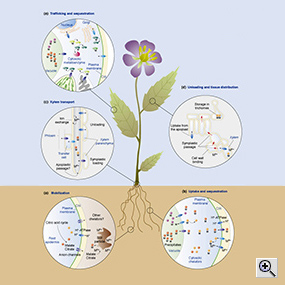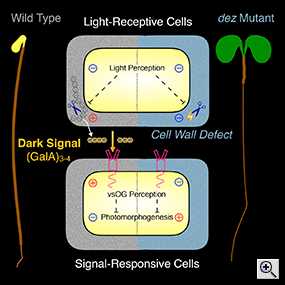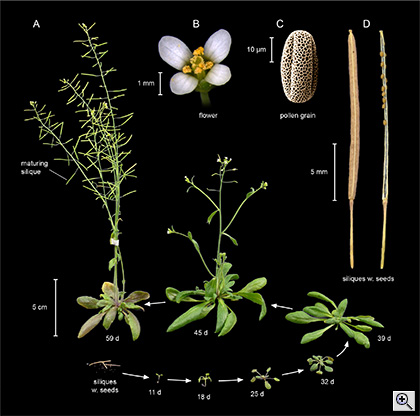Overview
Research Mission
Our vision is to provide multi-level functional knowledge on how a plant’s genotype relates to sub-cellular and inter-cellular processes in tissues, organs and across the entire plant, and to place this information into an ecological and evolutionary context. We address the molecular mechanisms underlying plant acclimation to their dynamic environment as well as evolutionary adaptation in plants. Our work integrates the disciplines of genome-enabled functional genomics, molecular and cell biology, physiology, ecology and evolutionary biology. With a strong emphasis on comparative approaches between and within species, we combine labwork, the characterization of natural populations in the field and outdoor experiments.
Figure 1: The plant metal homeostasis network. From: Clemens S, Palmgren MG, Krämer U (2002) A long way ahead: understanding and engineering plant metal accumulation. Trends Plant Sci. 7(7): 309-315 [Pubmed]
Figure 2: Seedlings develop differently in the dark and in the light. Dark-grown mutant seedlings with a specific cell wall defect mimick light-grown seedlings. From: Sinclair et al. (2017) Etiolated Seedling Development Requires
Repression of Photomorphogenesis by a Small Cell-Wall-Derived Dark Signal. Current Biology 27, 3403–3418 [DOI]
Research Topics
All life must build itself from inorganic compounds available on Earth and faces the perpetual challenge of balancing between states of nutritional limitation and toxic overload in a changeable environment. We address the molecular basis of traits that are outcomes of this fundamental environmental condition of biological existence. We explore the enormous natural diversity of these traits in plants, which – as primary producers – mediate between the inorganic and the living world.
Our research is primarily centred on the biology of so-called “class B and borderline” elements, traditionally addressed as “heavy metals”. These elements include, for example, the essential nutrients iron (Fe), zinc (Zn), copper (Cu) and manganese (Mn), as well as their toxic analogues cadmium (Cd) and lead (Pb). The choice of “model” elements towards our research mission is based on the reasoning that their uniquely potent specific chemical properties are indispensable across all biology and require particularly effective homeostasis mechanisms and local adaptations.
Figure 3: Life cycle of Arabidopsis thaliana. From: Krämer U (2015) Planting molecular functions in an ecological context with Arabidopsis thaliana. eLife 4 [DOI]
We advance our fundamental molecular understanding of how plants acclimate to their environment employing the classic genetic model plant Arabidopsis thaliana. Our research addresses novel roles for proteins of the metal homeostasis network in the control of plant development and metabolism. We work to elucidate fundamental molecular mechanisms of metal specificity and of the interactions between different metals. Finally, we study molecular mechanisms of inter-cellular and long-distance signalling.
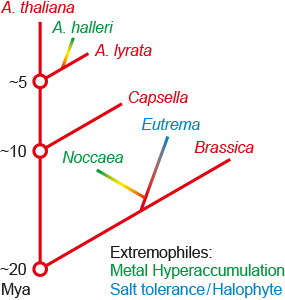
Figure 4: Brassicaceae species - A. halleri is a close related species to A. lyarata and A. thaliana
Our work on plant evolutionary adaptation targets the naturally selected extreme traits of metal hyperaccumulation and metal hypertolerance. These model traits are exquisitely suited for understanding rapid and parallel evolution and physiological adaptation to the environment, which are poorly understood in complex organisms to date. In our primary model species of interest in this work, Arabidopsis halleri, the so-called hyperaccumulation of toxic heavy metals zinc, cadmium and lead can act as an elemental defense against biotic stress, and hypertolerance to these metals is common. With respect to these metal-related traits, phenotypic differences between A. halleri and its closest relatives, for example A. lyrata and A. thaliana, are thus extreme, and intra-specific phenotypic variation in A. halleri is of an unparalleled magnitude.
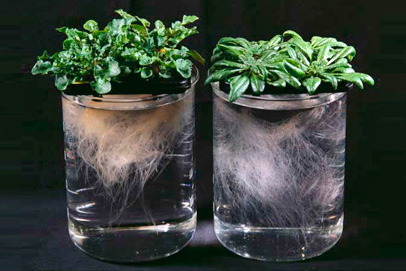
Figure 5: Arabidopsis halleri (left) and Arabidopsis thaliana (right) grown in hydroponic culture. Photo by Josef Bergstein, Max Planck Institute of Molecular Plant Physiology.
Research Outcomes and Applications
Our vision is to provide multi-level functional knowledge on how a specific plant genotype governs sub-cellular and inter-cellular processes in tissues, organs and across the entire plant in an ecological and evolutionary context. Importantly, we aim to generate insights of general relevance into the genetic and molecular basis of plant evolutionary adaptation to harsh environments or upon drastic environmental change.
Catastrophic impact and, more recently, human activities, have led to multiple incidences of dramatic environmental change during the history of life on Earth. How has life evolved to deal with this? Can we anticipate and influence the consequences to ensure human survival on Earth?
The results of our research can be directly applied in the development of sustainable phytomining technologies, as well as phytoremediation technologies for the clean-up of anthropogenically polluted environments.
Our research yields knowledge on micronutrient metal homeostasis, which can serve in the improvement of crop yields and of the sustainability of crop production on nutrient-poor soils. Moreover, our research can be applied in the improvement of the nutritional quality of crops through bio-fortification and the improvement of nutritional safety of crops. We are exploring these approaches using barley as a model cereal crop in applied research.
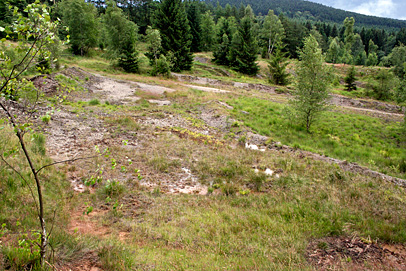
Figure 6: A typical heavy metal contaminated site around a former lead/zinc mine near Littfeld/Germany.
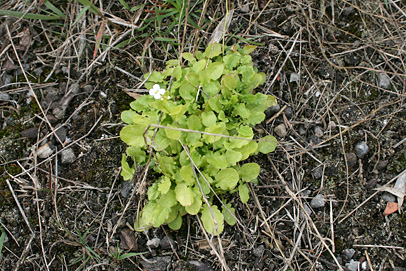
Figure 7: Arabidopsis halleri growing naturally at a heavy metal contaminated site around a former lead/zinc mine near Littfeld/Germany.








